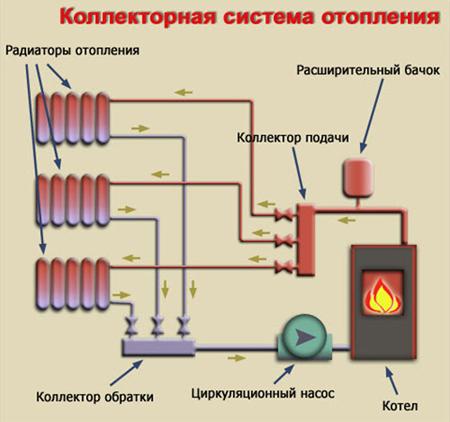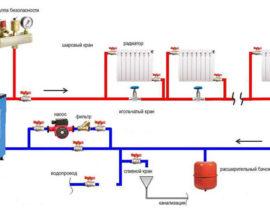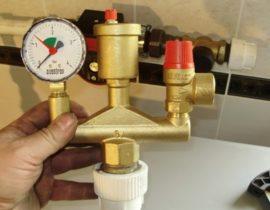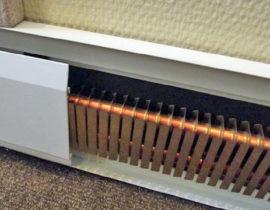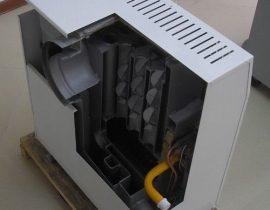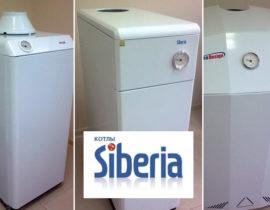The collector heating system, which involves the individual connection of each heating radiator to the distributor, has a lot of advantages, but the key is still to maximize savings and reduce the cost of paying for individual heating. The coolant, which is distributed depending on the degree of cooling of a particular heating section, cools down more slowly, respectively, fuel consumption is reduced.
For apartments, such a connection will be quite costly and impractical, but for private houses with a heated area of more than 150 square meters, the collector system will solve several issues at the same time. In addition to the advantages, there are also disadvantages that are associated with installation. But, given the end result, such a scheme for a private house is the most advantageous.
Content
Features and arrangement of the collector heating system
We are accustomed to the fact that the heating system is a closed line that has a return line, where under the influence circulation pump the coolant passes through all the radiators and returns back to the boiler, forcing it to work if a temperature difference is created.
This allows you to control the temperature in the house yourself.For example, in a large room, more heat is needed to heat the air, and in a small room, it will be enough to set the thermostat to the lowest value. This is extremely convenient, since you do not need to add additional radiators to the circuit if the area of \u200b\u200bthe room is large.
The collector heating system consists of the following structural parts:
 Distribution node (comb or manifold) - a part of a pipe with one inlet and with any number of outlets, through which the coolant is distributed for each specific radiator or an independent ring, consisting of 3-5 radiators connected internally in series.
Distribution node (comb or manifold) - a part of a pipe with one inlet and with any number of outlets, through which the coolant is distributed for each specific radiator or an independent ring, consisting of 3-5 radiators connected internally in series.- Expansion tank - through it the heating system is fed with water, which is necessary to create a certain pressure.
- Circulation pump - pumps water, forcing it to move through the heating system.
- Pressure regulating devices and ensuring the safe use of the entire heating system.
Often in practice a mixed collector heating system is used, breaking it into circuits. For example, there are 7 large rooms, for each of which a separate circuit is allocated, which has its own exit on the comb. At the same time, in each of these rooms (and they are different in size, respectively, they need a different number of radiators) there can be a completely different number of radiators: 2, 3, 5, 7.
So those radiators that will be located within the same room will be connected to each other in series, and in relation to the entire heating system - in parallel, since there will be exactly as many such circuits as there are heated rooms.
Consider in practice how the collector heating system works:
Water is heated from a heat source (boiler), after which it enters the comb.
- The heated coolant is distributed through the outlets to all circuits.
- The cooled water returns through the collector return, after which it passes into the boiler, where it heats up to the desired temperatures and makes the return journey.
Collectors are installed in separate cabinets in a separate room, access to which is always available. Each hydraulic network leaving the collector is equipped with a locking mechanism that allows you to turn off individual heating links without completely turning it off throughout the house.
In addition, each radiator in the system must be equipped with Mayevsky's crane to bleed air from the system. Alternatively, an air vent valve on the manifold itself.
Advantages and disadvantages
The collector heating system has the following advantages:
- Saving fuel consumption for heating large areas - the coolant in the process of passing to the radiators performs the function of heat exchange with less losses, which saves money during the heating season.
- The ability to independently determine the desired temperature in different rooms - the person himself regulates the desired temperature, disconnecting individual parts from the overall system.
- Pipes are ideally hidden in the floor screed, which will save the room from outdated decor in the form of pipes.
- Convenient repair - it is enough to turn off a separate section, and in other rooms the heating will continue to function as before.
Despite the apparent savings, such a system has some disadvantages:
- High pipe consumption, which will lead to additional expenses.
- Full functioning depends on the availability of electricity in the network.If the light is turned off, then the pump will not be able to pump water, respectively, the heat exchanger circulation process will be absent and the radiators will quickly cool down.
- The relatively high cost of all elements of the system, the payback of which will be more than 2-3 years.
In the process of laying pipes in a concrete screed, it is important to take into account such a nuance that the place of any coupling is a potential place for a leak, and if it occurs, you will have to remove the floor and spend money on quite expensive repairs.
Schemes and expert advice
The advantage of the collector heating system is also the fact that the exact circuits in connecting individual elements to collector no. You can choose the option that is most suitable, and the design begins with capacity calculations.
Here it is important to take into account such nuances:
- Calculate the required number of radiators for each individual room. For every 20 squares of area, 1 medium radiator is enough, which is better placed under window openings.
- Determine the number of circuits - usually this figure is equal to the number of heated rooms. The number of nozzles on the comb will depend on this value.
- Identify the required boiler power and select the appropriate model - the power parameters directly depend on the heated area.
- Determine location expansion tank, the volume of which should be at least 3% of the total volume of the coolant.
- Select a suitable circulation pump and determine the optimal power of its operation.
As for materials, experts recommend giving preference to stainless steel collectors. It has a longer service life, and greater resistance to pressure drops, and temperature surges will not cause problems. The disadvantages of the material include its high cost.
Brass is a more budget option, while maintaining excellent performance. The service life of such a comb is limited, but it will be enough for 10-15 years.
Now on the market you can find a huge number of combs made of polypropylene. Manufacturers promise the strength and reliability of the design, as well as ease of installation, which in practice is not true. The service life hardly reaches 3-5 years. Even despite the low cost, it is better to exclude this option, since then you will have to spend money on replacing the comb more than once.
As for the choice of pipes, it is better to give preference to metal-plastic. It bends well, and takes any shape and will last a very long time, having increased strength.
FAQ
The circulation pump shaft must be horizontal. If you change this position to the opposite, the pump will periodically overheat and will soon fail.
It is possible, such a system fits all the requirements, after which it is thrown onto the dedicated nozzles of the comb. The main condition is that the individual circuits do not communicate with each other.
It is possible, for this you need to use the necessary material and tool, having previously calculated the number of nozzles. This is only relevant if there is a skill in using a welding machine. It is best to purchase combs from the manufacturer, preferring stainless steel.
In conclusion, it is worth noting that the collector heating system performs well in large heated areas and is ideal for a private house.In an apartment, a parallel connection is usually not used due to the short duration of the circulation circle.
For an apartment, the sequential installation of radiators is better suited. The collector system allows you to adjust the temperature in individual rooms, and if repairs are necessary, you can easily turn off the desired element, while in other rooms you do not have to turn off the heating.
Video review of the collector heating system


